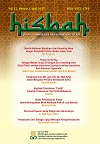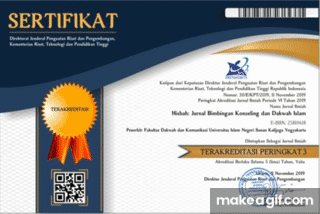ANALISIS RASCH MODEL: VALIDITAS DAN RELIABILITAS INSTRUMEN KORBAN BULLYING
DOI:
https://doi.org/10.14421/hisbah.2022.192-04Abstract
The phenomenon of bullying is still rife among high school adolescents in Indonesia. This study aims to develop an instrument that measures the number of victims of bullying at school. The study involved adolescents with an age range of 12-14 years at a junior high school in West Bandung Regency, West Java, Indonesi a. This study used a quantitative method with a questionnaire containing 18 items which had 4 Likert answer choices. Data analysis used the Rasch model approach, and used Winstep 3.73 software. The results of the analysis show that personal reliability is 0.49 which indicates that the consistency of participants in answering questions is included in the weak category, and item reliability is 0.95 which indicates that the quality of the item items is classified as special. It can be concluded that the instrument for victims of bullying already has items that are classified as special, it's just that the consistency of participants in answering questions is still weak, and the level of interaction between participants and items is also lacking.
Keywords: Validity, reliability, Rasch model, victims of bullying
 Abstract viewed: 1152 times
|
Abstract viewed: 1152 times
|
 PDF downloaded = 1446 times
PDF downloaded = 1446 times
References
Alagumalai, S., Curtis, D. D., & Hungi, N. (2005). Applied Rasch measurement: A book of exemplars. Dordrecht, The Netherlands: Springer, 1–15. https://doi.org/https://doi.org/10.1007/1-4020-3076-2
Ashofa, N. H. (2019). Terapi Realitas untuk Menangani Trauma (Post Traumatic Stress Disorder) pada Korban Bullying di Balai Perlindungan dan Rehabilitasi Sosial Wanita Yogyakarta. Hisbah: Jurnal Bimbingan Konseling Dan Dakwah Islam, 16(1), 86–99. https://doi.org/https://doi.org/10.14421/hisbah.2019.161-07.
Byrne, B. (1994). Coping with bullying in schools.
Çetin, B., Yaman, E., & Peker, A. (2011). Cyber victim and bullying scale: A study of validity and reliability. Computers & Education, 57(4), 2261–2271. https://doi.org/https://doi.org/10.1016/j.compedu.2011.06.014
Cheng, Y. Y., Chen, L. M., Liu, K. S., & Chen, Y. L. (2011). Development and psychometric evaluation of the school bullying scales: A Rasch measurement approach. . . Educational and Psychological Measurement, 71(1), 200–216.
Coelho, V. A., Sousa, V., Marchante, M., Brás, P., & Romão, A. M. (2016). Bullying and cyberbullying in Portugal: Validation of a questionnaire and analysis of prevalence. School Psychology International, 37(3), 223–239. https://doi.org/https://doi.org/10.1177/0143034315626609
Creswell, J. W. (2016). Research Design: Pendekatan Metode Kualitatif, Kuantitatif, dan Campuran. Yogyakarta: Pustaka Pelajar.
Gonçalves, F. G., Heldt, E., Peixoto, B. N., Rodrigues, G. A., Filipetto, M., & Guimarães, L. S. P. (2016). Construct validity and reliability of Olweus bully/victim questionnaire–Brazilian version. Psicologia: Reflexão e Crítica, 29. https://doi.org/https://doi.org/10.1186/s41155-016-0019-7
Indihadi, D., Suryana, D., & Ahmad, A. B. (2022). The analysis of construct validity of Indonesian creativity scale using Rasch model. Creativity Studies, 15(2), 560–576. https://doi.org/https://doi.org/10.3846/cs.2022.15182
Kyriakides, L., Kaloyirou, C., & Lindsay, G. (2006). An analysis of the Revised Olweus Bully/Victim Questionnaire using the Rasch measurement model. British Journal of Educational Psychology, 9(1), 56–73. https://doi.org/https://doi.org/10.1080/15388220903185613
Lee, T., & Cornell, D. (2009). Concurrent validity of the Olweus bully/victim questionnaire. . . Journal of School Violence, 9(1), 56–73. https://doi.org/https://doi.org/10.1080/15388220903185613
Muslihin, H. Y., Suryana, D., Suherman, U., & Dahlan, T. H. (2022). Analysis of the Reliability and Validity of the Self-Determination Questionnaire Using Rasch Model. International Journal of Instruction, 15(2).
Nur, L., Yulianto, A., Suryana, D., Malik, A. A., Ardha, M. A. A., & Hong, F. (2022). An Analysis of the Distribution Map of Physical Education Learning Motivation through Rasch Modeling in Elementary School. International Journal of Instruction, 15(2), 815–830.
Olweus, D. (1993). Bullying at School: What We Know and What We Can Do. Blackwell: UK.
Purwana, U., Rusdiana, D., & Liliawati, W. (2020). Pengujian Kemampuan Menginterpretasikan Grafik Kinematika Calon Guru Fisika: the Polytomous Rasch Analysis. ORBITA: Jurnal Kajian, Inovasi Dan Aplikasi Pendidikan Fisika, 6(2), 259–266.
Sharp, S., & Smith, P. (2002). School bullying: Insights and perspectives. Routledge.
Staszek, T., E., Zych, I., & Ortega-Ruiz, R. (2018). Bullying and cyberbullying in Polish elementary and middle schools: Validation of questionnaires and nature of the phenomena. Children and Youth Services Review, 95, 217–225. https://doi.org/https://doi.org/10.1016/j.childyouth.2018.10.045
Suryani, Y. E. (2018). Aplikasi rasch model dalam mengevaluasi Intelligenz Structure Test (IST). Psikohumaniora: Jurnal Penelitian Psikologi, 3(1), 73–100. https://doi.org/https://doi.org/10.21580/pjpp.v3i1.2052
Tattum, D. (1993). Understanding and Managing Bullying. Clay Ltd: Great Britain.
Tattum, D., & Herbert, G. (1993). Countering Bullying: Initiative By School and Local Authorities. London: Trentham Books.
Taufiq, A., Yudha, E. S., Md, Y. H., & Suryana, D. (2021). Examining the Supervision Work Alliance Scale: A Rasch Model Approach. The Open Psychology Journal, 14(1). https://doi.org/https://doi.org/10.2174/1874350102114010179
Yusuf, S., Budiman, N., Yudha, E. S., Suryana, D., & Yusof, S. M. J. B. (2021). Rasch Analysis of the Indonesian Mental Health Screening Tools. The Open Psychology Journal, 14(1). https://doi.org/https://doi.org/10.2174/1874350102114010198

Downloads
Published
Issue
Section
License
Authors who publish with this journal agree to the following terms:
- Authors retain copyright and grant the journal right of first publication with the work simultaneously licensed under a Creative Commons Attribution License that allows others to share the work with an acknowledgement of the work's authorship and initial publication in this journal.
- Authors are able to enter into separate, additional contractual arrangements for the non-exclusive distribution of the journal's published version of the work (e.g., post it to an institutional repository or publish it in a book), with an acknowledgement of its initial publication in this journal.
- Authors are permitted and encouraged to post their work online (e.g., in institutional repositories or on their website) prior to and during the submission process, as it can lead to productive exchanges, as well as earlier and greater citation of published work.











